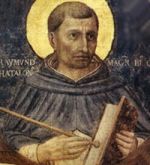Catholic Recipe: Pope Ladies
Pope Joan was a mythical woman pope who supposedly lived in the middle of the ninth century and was elected to the papacy sometime between the period of Leo IV and Benedict III. One story is that Joan was born in England; another, that she was born in Germany, of English parentage. She studied at Cologne where, according to some chroniclers, she fell in love with a Benedictine monk. Tradition says that Joan disguised herself as a man, took the name of Joannes Angelicus, John of England, and fled to Athens with the monk. There he finally died, and Joannes journeyed to Rome and entered the priesthood. In time Joannes became a cardinal and later, when Pope Leo IV died, she succeeded him under the name of John VIII.
The myth of Pope Joan was well known between the thirteenth and seventeenth centuries. Nowadays the career of the legendary adventuress is all but forgotten. But some excellent little buns, known as pop, or pope ladies, and a once popular card game that bears her name, are evidences of Pope Joan's enduring fame.
A few generations ago, "Popeladies! Popeladies!" was a familiar street cry on New Year's Day in the ancient Hertfordshire town of Saint Albans, where hucksters carried about baskets of curious-looking buns and bakeshops displayed them in windows. Pope ladies went out of fashion long ago. This is strange, too, since they taste much like hot cross buns. Their shape delights the fancy of children and arouses the curiosity of adults. The form of pope ladies is indeed extraordinary. Nobody knows how it originated. The dough is fashioned into the rude outlines of a female figure. A small round bun with currant eyes makes the head. The body, which has no legs and ends in a point, resembles nothing so much as an Egyptian mummy case. Two small lumps at the sides indicate arms.
Today pope ladies are an amusing accompaniment to punch or hot spiced cider at the New Year's party. Drop-in guests on New Year's Day will appreciate them hot, with homemade preserves, and coffee or tea.
DIRECTIONS
Scald milk, add butter, sugar, and salt. Stir, and when cooled to lukewarm add yeast, which has first been thoroughly dissolved in the water. Sift together flour and nutmeg, and add gradually to the first mixture. Combine thoroughly. Add beaten eggs and mix together to make soft dough. Set to rise overnight in warm place, in a greased covered bowl.
In the morning punch down the dough and shape into small buns that look something like this:
Add currants for eyes, a tiny knob of dough for nose and two small strips for arms. Lay the buns about 3 inches apart in a greased pan and let rise in warm room. Brush over the top with mixture of egg yolk beaten with 1 tablespoon water. Bake about 20 minutes in moderately hot oven (350° F.)
Recipe Source: Feast-Day Cakes from Many Lands by Dorothy Gladys Spicer, Holt, Rinehart and Winston, 1960





